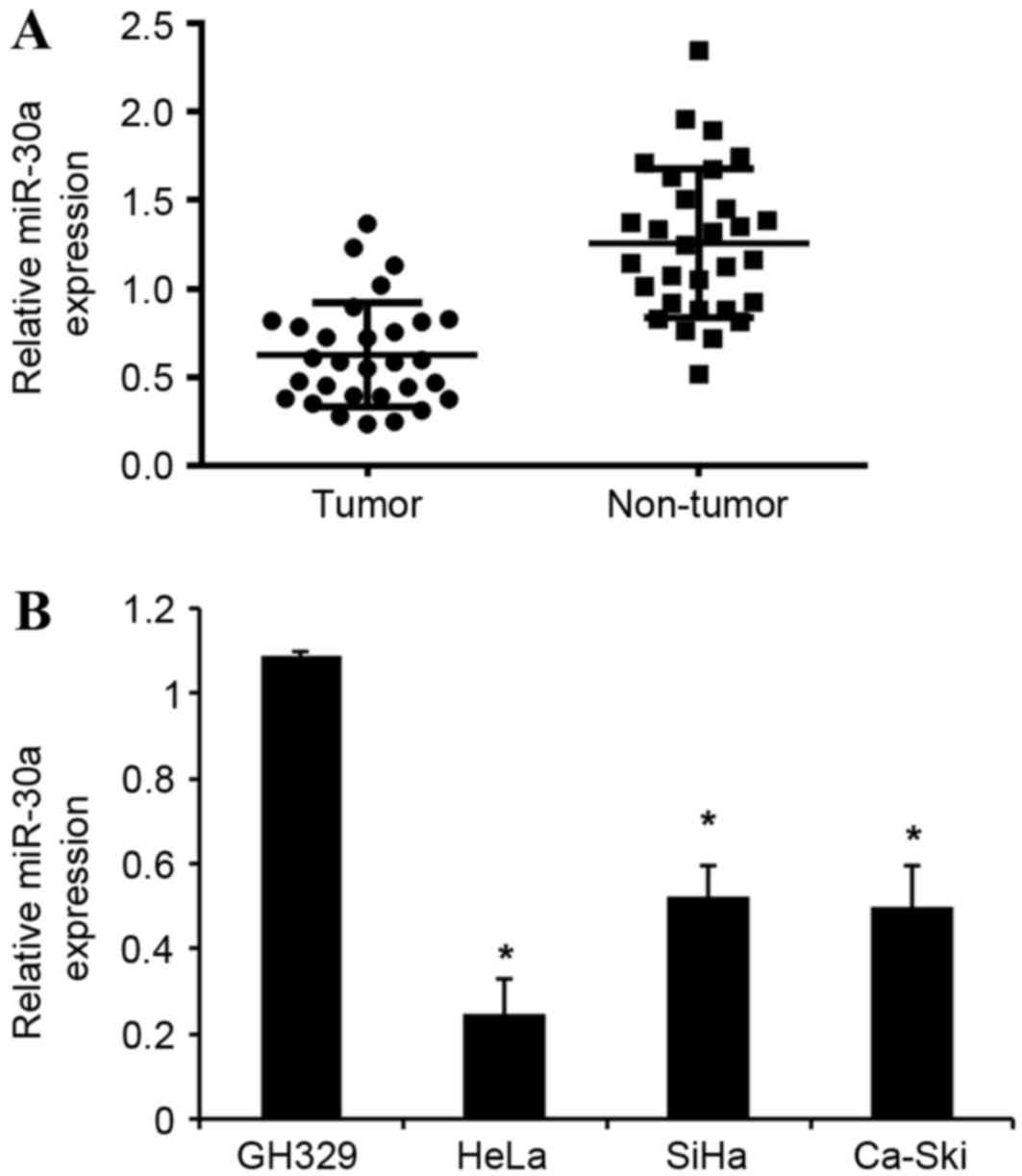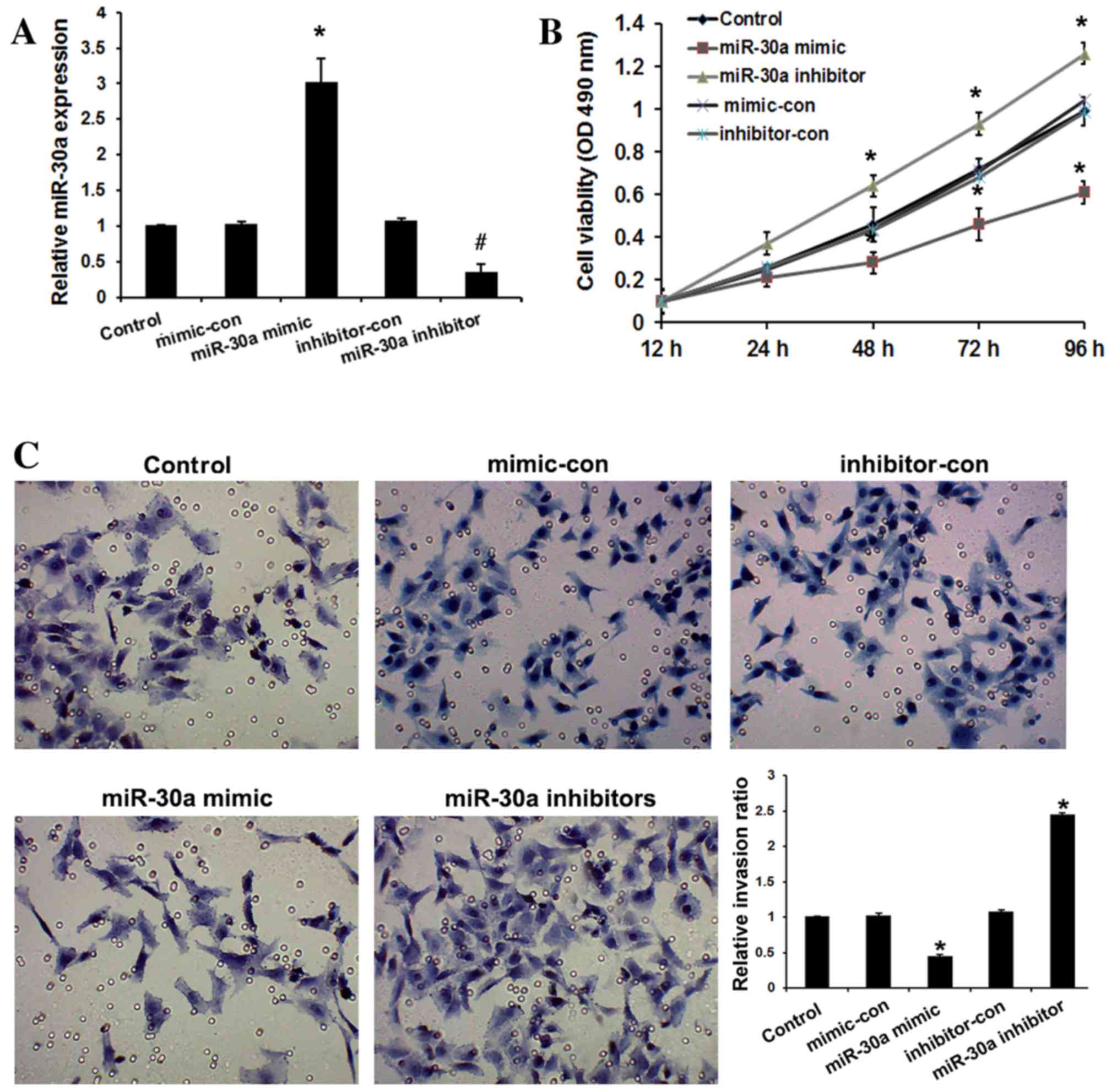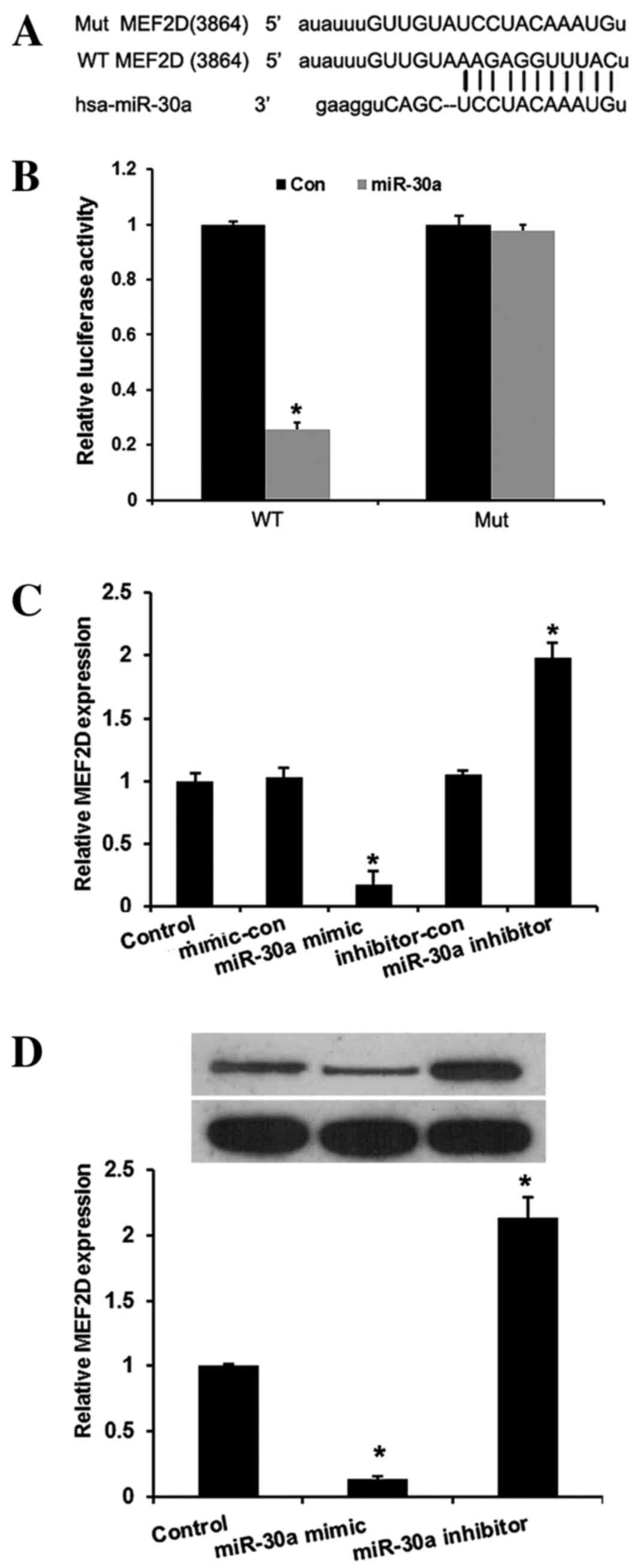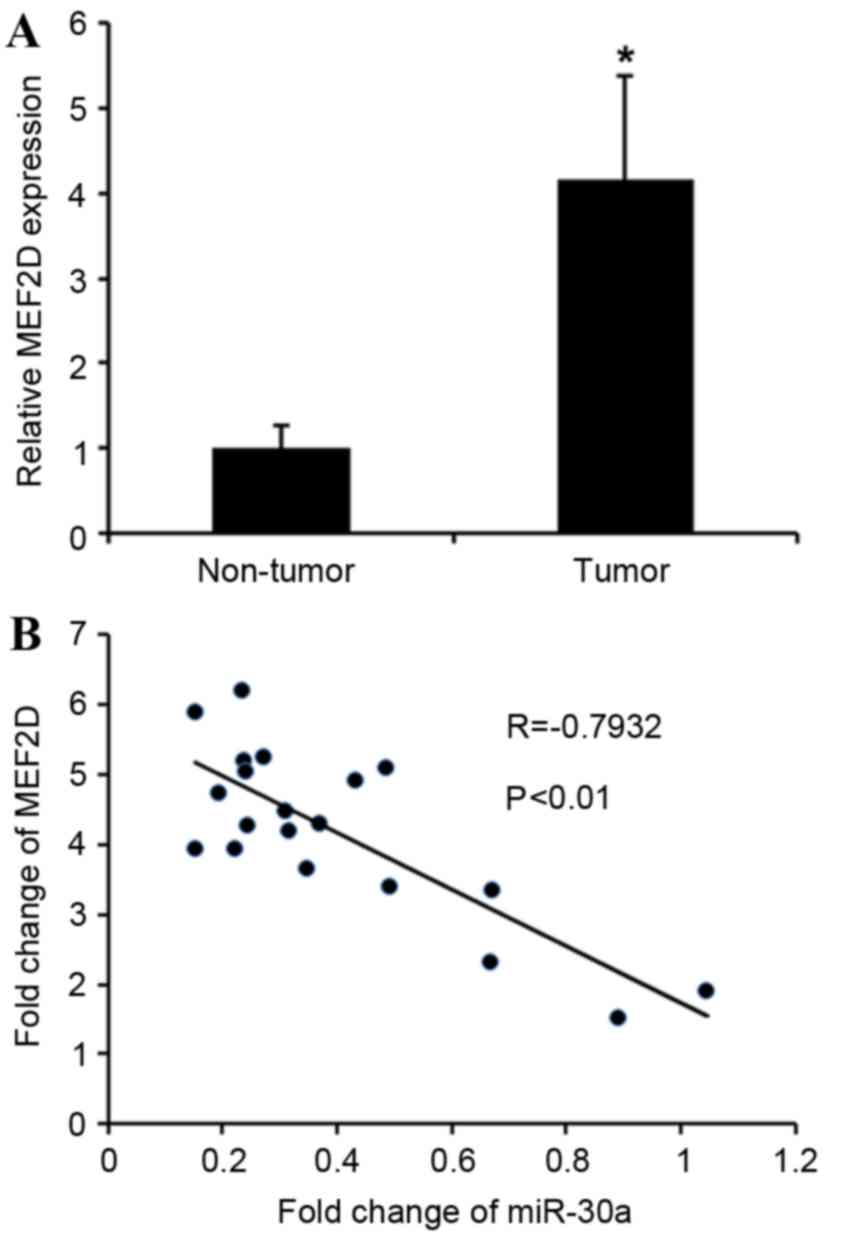Downregulation of miR‑30a is associated with proliferation and invasion via targeting MEF2D in cervical cancer
Retraction in: /10.3892/ol.2023.14168
- Authors:
- Published online on: October 2, 2017 https://doi.org/10.3892/ol.2017.7114
- Pages: 7437-7442
Abstract
Introduction
Cervical carcinoma is one of the most common types of cancer and fourth leading cause of cancer-associated mortality in women worldwide (1). There are ~529,800 newly diagnosed cervical carcinomas and 275,100 cervical carcinoma-associated mortalities every year, accounting for ~9% of all female cancer incidence and mortality (2). It is estimated that >80% of these cases occur in developing countries (3). Despite recent advances in diagnostic and treatment strategies in clinical and experimental oncology, the 5-year overall survival rate for patients with advanced disease remains low (4). Therefore, it is critical to improve the understanding of the molecular mechanisms of cervical carcinoma tumorigenesis and progression in order to facilitate the development of efficient methods for individualized early diagnosis and treatment of the disease.
MicroRNAs (miRNAs) are an abundant group of small noncoding RNAs (~22 nucleotides each). They control the expression of target genes by binding to the 3′-untranslated region (UTR) of their associated mRNAs and serve an important role in a variety of biological processes, including cell proliferation, apoptosis, differentiation, invasion and migration (5–8). Accumulating studies are demonstrating that miRNAs are dysregulated in a variety of cancers and serve a critical role in tumorigenesis (9–14). Recent studies demonstrated that miRNAs are critical regulators in the development and progression of cancer, including cervical cancer (15,16). Therefore, identification of novel miRNAs involved in cervical cancer progression may contribute to the development of prognostic biomarkers and therapeutic strategies for cervical cancer.
The miR-30 family contains six distinct mature miRNA sequences: miR-30a/miR-30c-2, miR-30d/miR-30b, and miR-30e/miR-30c-1 (17). Accumulating evidence indicates that the dysregulation of miR-30a contributes to various malignant tumors, including lung, thyroid, gastric, breast and colon cancer (18–23). miR-30a promotes tumorigenesis in these cancers by directly targeting tumor-associated proteins. Zhang et al (24) demonstrated that miR-30c inhibited the growth and lung metastasis of colon cancer by targeting ADAM metallopeptidase domain 19. miR-30a has also been reported to target insulin receptor substrate 2 in colorectal tumorigenesis (18). However, the expression and role of miR-30a in the progression of cervical cancer remains unclear.
In the present study, the dysregulated expression of miR-30a in cervical cancer was revealed, and the effect of miR-30a on cervical cancer cell proliferation and invasion was investigated. Furthermore, myocyte enhancer factor 2D (MEF2D), which promotes cervical cancer progression, was identified as a direct target of miR-30a. In conclusion, miR-30a acts as a tumor suppressor and may serve as a potential therapeutic target in cervical cancer.
Materials and methods
Human tissue specimens
Paired cervical cancer and matched normal tissue specimens were obtained with informed consent from 20 cervical cancer patients (age range 30–62; mean age 45 years) that had not undergone preoperative chemotherapy or radiotherapy between January 2014 to December 2015 at the Hunan Provincial Maternal and Child Health Hospital (Changsha, China). All tissues were obtained during surgery and immediately stored in liquid nitrogen until use. The Institute Research Medical Ethics Committee of Hunan Provincial Maternal and Child Health Hospital granted approval for this study.
Cell culture and transfection
The cervical cancer cell lines HeLa, SiHa and Ca-Ski, as well as the normal human cervical epithelial GH329 and human embryonic kidney 293 cell lines, were obtained from the American Type Culture Collection (Manassas, VA, USA). All cells were cultured in Dulbecco's modified Eagle's medium (DMEM; Invitrogen; Thermo Fisher Scientific, Inc., Waltham, MA, USA) supplemented with 10% fetal bovine serum (FBS; Invitrogen; Thermo Fisher Scientific, Inc.). Cultures were maintained at 37°C in a humidified atmosphere with 5% CO2.
miR-30a mimic, miR-30a inhibitor, mimic negative control, and inhibitor negative control were synthesized by Shanghai GenePharma Co., Ltd. (Shanghai, China). For transfection, HeLa cells were seeded in 12-well plates and transiently transfected with 100 nM of the following mimics/inhibitors: miR-30a (hsa-miR-30a) mimic, miR-30a inhibitor, mimic negative control (designated as mimic control), and inhibitor negative control (designated as inhibitor control) for 8 h using Lipofectamine 2000 according to the manufacturer's protocol (Invitrogen; Thermo Fisher Scientific, Inc.). A total of 24 h after transfection, cells were collected for qPCR, cell viability and invasion. After 48 h transfection, cells were collected for western blotting.
Reverse transcription-quantitative polymerase chain reaction (RT-qPCR)
The RNA was extracted from human cervical cancer cells and tissue specimens, as well as normal cervical cells and tissues, using TRIzol solution (Sigma-Aldrich; Merck Millipore, Darmstadt, Germany). RT was performed to obtain complementary DNA using a PrimeScript RT Reagent kit (Takara Bio, Inc., Otsu, Japan) according to the manufacturer's protocol. gDNA eraser was added to 1 µg RNA at 42°C for 2 min, and RT Primer mix was added at 37°C for 15 min, followed by 85°C for 5 sec. qPCR was performed with SYBR Premix Ex Taq II (Takara Bio, Inc.) using 300 ng cDNA with the CFX96™ Real-Time PCR Detection System (Bio-Rad Laboratories, CA). The cycling conditions for the qPCR were 95°C for 2 min followed by 45 cycles of 95°C for 15 sec and 60°C for 30 sec. The primer sequences for miR-30a and MEF2D were described previously (18,25). miR-30a expression in each sample was calculated by normalizing with U6 and the MEF2D expression in each sample was calculated by normalizing with GAPDH. U6 forward, 5′-CTCGCTTCGGCAGCACA-3′ and reverse, 5′-AACGCTTCACGAATTTGCGT-3′; and GAPDH forward, 5′-CGGAGTCAACGGATTTGGTCGTAT-3′ and reverse, 5′-AGCCTTCTCCATGGTGGTGAAGAC-3′ The expression level of each miRNA was measured using the 2ΔΔCq method (26). All samples were run in triplicates in the same culture plate.
Luciferase reporter gene assays
miRNA target prediction websites www.microRNA.org and TargetScan (www.targetscan.org) were used to predict the target gene of miR-30a. The 3′-UTR of MEF2D containing the putative binding site of miR-30a was amplified and subcloned into a pGL3 luciferase promoter vector (Promega Corporation, Madison, WI, USA), as described previously (27); the putative binding site was mutated as negative control (MEF2D-Mut). The vector was co-transfected with miR-30a mimic into 293 cells for 48 h. The cells were harvested and relative luciferase activity was detected using a Dual-Luciferase Reporter Assay System (Promega Corporation) according to the manufacturer's protocol. All experiments were performed at least three times.
Western blot analysis
Whole cell extracts were prepared with radioimmunoprecipitation assay buffer according to the manufacturer's protocol (Sigma-Aldrich; Merck Millipore), and the protein was quantified using a Pierce BCA Protein Assay kit (Thermo Fisher Scientific, Inc.). The protein samples (30 µg) were separated by SDS-PAGE (10%), transferred to a methanol-activated polyvinylidene fluoride membrane and blocked with 5% milk at room temperature for 1 h, and then detected by western blot using a polyclonal rabbit anti-MEF2D antibody (1:1,000, HPA004807, Santa Cruz Biotechnology, Inc., Santa Cruz, CA, USA), incubated at 4°C overnight. The membranes were subsequently incubated with a goat anti-rabbit IgG secondary antibody (1:5,000; cat. no. 65-6120; Pierce; Thermo Fisher Scientific, Inc.) at room temperature for 1 h conjugated to horseradish peroxidase. Blots were then developed using an Enhanced Chemiluminescence kit (Pierce; Thermo Fisher Scientific, Inc.) following manufacturer's instructions. ImageJ v2.1.4.7 (National Institutes of Health, Bethesda, MD, USA) was used to quantify band density of western blot experiments.
Cell viability assay
An MTT assay was employed to assess cell viability, as described previously (28), in HeLa cells transfected with miR-30a mimic, inhibitor, mimic control or inhibitor control.
Invasion assay
A total of 24 h after HeLa cells were transiently transfected with the aforementioned mimics/inhibitors, cell invasion ability was examined by Transwell invasion assay. Cells were seeded (2×105 cells/well) into 12-well plates. The Transwell migration chambers were used to evaluate cell invasion. Transwell insert chambers were covered with Matrigel (BD Biosciences, Franklin Lakes, NJ, USA) to detect the ability of invasion. Matrigel (10 mg/ml) was coated on the upper side of the filter, and collagen was coated on the lower side of the filter. The upper chamber was filled with cells in serum-free DMEM, and the lower chamber was filled with DMEM containing 5% FBS. Cells were incubated for 48 h at 37°C, and then non-invading cells were removed by swabbing the top layer of Matrigel with a cotton swab. The cells were stained with 0.1% Crystal Violet Staining for 15 min at 37°C. For each well, ten random fields were counted and the average number of cells was determined under a light microscope at ×100 magnification. The invasion ratio was equal to the cell number in the experimental group divided by the cell number in the control group. All the experiments were repeated in triplicate.
Statistical analysis
Each experiment was repeated at least three times. Data are presented as the mean ± SD and analyzed using SPSS 19.0 (IBM SPSS, Armonk, NY, USA). Comparison of more than two groups was made using one-way analysis of variance with Tukey's post hoc test. Comparison of two groups was made using Student's t-test for unpaired data. P<0.05 was considered to indicate a statistically significant difference.
Results
miR-30a is downregulated in cervical cancer tissues and cell lines
miR-30a expression was detected in 20 human cervical cancer and adjacent normal tissues, as well as in cervical cancer and normal cervical cell lines, using an RT-qPCR assay. As shown in Fig. 1A, miR-30a expression was significantly downregulated in cervical cancer tissues compared with corresponding adjacent normal tissues. Furthermore, the expression levels of miR-30a in the three cervical cancer cells (HeLa, SiHa and Ca-Ski) were significantly downregulated compared with that of human normal cervical cell line GH329 (Fig. 1B). Collectively, these data suggest that the downregulation of miR-30a may be involved in the tumorigenesis of cervical cancer.
miR-30a inhibits cervical cancer cell viability and invasion
To evaluate the role of miR-30a in cervical cancer progression, HeLa cells were transfected with miR-30a mimic, inhibitors, and their respective negative controls. As shown in Fig. 2A, miR-30a mimic significantly upregulated miR-30a expression, while miR-30a inhibitors significantly downregulated miR-30a expression in HeLa cells compared with the controls (P<0.05). The effect of miR-30a on the viability of HeLa cells was examined by MTT assay. It was observed that overexpression of miR-30a resulted in significantly decreased viability of cervical cancer cells relative to the controls after 48 h (P<0.05), whereas miR-30a inhibitors increased the viability of HeLa cells relative to the controls (P<0.05; Fig. 2B). To determine the function of miR-30a in cervical cancer progression, the invasive abilities of transfected cell were determined. Compared with the controls, overexpression of miR-30a in cervical cancer cells significantly suppressed cell invasion (P<0.01), whereas loss of its expression promoted invasion (P<0.01; Fig. 2C). These observations suggest that miR-30a serves an important role in inhibiting the invasiveness of cervical cancer cells.
miR-30a inhibits MEF2D expression by binding to its 3′-UTR
In the present study, miRNA target prediction websites www.microRNA.org and TargetScan (www.targetscan.org) predicted that MEF2D is one of the targets of miR-30a. A conserved miR-30a-binding site in the 3′-UTR of MEF2D mRNA was identified. To verify this, a wild-type or mutant target region sequence of the MEF2D 3′-UTR was cloned and inserted into a luciferase reporter vector (Fig. 3A). These reporter vectors were co-transfected along with the miR-30a mimic and mimic control into the HEK293 cell line. As shown in Fig. 3B, the Dual-Luciferase reporter assay revealed that miR-30a mimic suppressed the luciferase activity of the reporter with wild-type MEF2D 3′-UTR sequence and failed to inhibit that of mutated MEF2D, indicating that MEF2D is one of the direct targets of miR-30a in cervical cancer cells. To further confirm MEF2D as a direct target of miR-30a, RT-qPCR and western blot assays were used to detect the expression of MEF2D in HeLa cells. As shown in Fig. 3C and D, the mRNA and protein levels of MEF2D were significantly downregulated by miR-30a mimic and upregulated by miR-30a inhibitors in HeLa cells compared with the controls (P<0.01).
MEF2D expression is increased in cervical cancer and inversely correlated with miR-30a levels
The association between MEF2D and miR-30a was further analyzed by detecting the mRNA expression levels of MEF2D in cervical cancer tissues. MEF2D levels in cervical cancer tissues were greatly upregulated compared with adjacent non-tumor tissues (Fig. 4A). MEF2D levels were compared with miR-30a expression in the same cervical cancer specimens. As shown in Fig. 4B, Spearman's correlation analysis demonstrated a significant inverse correlation between the levels of miR-30a and MEF2D mRNA (r=−0.7932; P<0.01). Taken together, these data strongly support the hypothesis that MEF2D is a direct target of miR-30a.
Discussion
Increasing evidence has indicated that miRNAs are involved in tumorigenic processes by targeting a variety of tumor-associated genes (29). Previous studies have demonstrated that miR-30a is involved in the progression of various malignant tumors (20,21,23). However, the mechanism of miR-30a in the progression of cervical cancer remains unclear. In the present study, it was revealed that miR-30a expression was significantly downregulated in cervical cancer tissue and cell lines. Further investigation indicated that miR-30a was able to regulate the viability and invasion of cervical cancer cells by targeting MEF2D. Therefore, for the first time, miR-30a has been revealed as a tumor suppressor in the progression of cervical cancer.
The MEF2 transcription factors serve roles in muscular, cardiac, skeletal, vascular, neural, blood and immune cell development through their effects on cell differentiation, proliferation, apoptosis, migration, morphology and metabolism (30). Altered MEF2 activity serves a role in human diseases and it has recently been implicated in the initiation and progression of various types of cancer in humans (31). Recently, it was reported that MEF2D, one member of MEF2 family, is involved in the progression of several cancer types, including lung carcinoma (27), rhabdomyosarcoma (32), hepatocellular carcinoma (31) and osteosarcoma (25).
In the present study, a luciferase reporter assay revealed that MEF2D is a direct target of miR-30a in cervical cancer cells. Overexpression of miR-30a reduced MEF2D mRNA and protein levels in cervical cancer cells. A significant negative correlation was observed between the levels of miR-30a and MEF2D mRNA in the same cervical cancer specimens. These results indicated that miR-30a functions as a tumor suppressor in cervical cancer by targeting MEF2D.
Taken together, the results of the present study have revealed for the first time that miR-30a is a tumor suppressor in cervical cancer; that the expression levels of miR-30a were significantly decreased in tumor tissues and cell lines, and that its ectopic expression inhibited cell proliferation and invasion. Furthermore, a Dual-Luciferase reporter assay revealed that MEF2D is a direct target of miR-30a, and MEF2D mRNA expression was shown to be negatively correlated with miR-30a expression in cervical cancer. These results indicate that miR-30a dysregulation may serve important roles in cervical cancer progression and that the interaction between miR-30a and MEF2D may be a therapeutic target in the treatment of cervical cancer.
References
|
Kanavos P: The rising burden of cancer in the developing world. Ann Oncol. 17 Suppl 8:viii15–viii23. 2006. View Article : Google Scholar : PubMed/NCBI | |
|
Reeler A, Qiao Y, Dare L, Li J, Zhang AL and Saba J: Women's cancers in developing countries: From research to an integrated health systems approach. Asian Pac J Cancer Prev. 10:519–526. 2009.PubMed/NCBI | |
|
Jemal A, Siegel R, Ward E, Hao Y, Xu J and Thun MJ: Cancer statistics, 2009. CA Cancer J Clin. 59:225–249. 2009. View Article : Google Scholar : PubMed/NCBI | |
|
Sharma V, Kerr SH, Kawar Z and Kerr DJ: Challenges of cancer control in developing countries: Current status and future perspective. Future Oncol. 7:1213–1222. 2011. View Article : Google Scholar : PubMed/NCBI | |
|
Li Z, Lei H, Luo M, Wang Y, Dong L, Ma Y, Liu C, Song W, Wang F, Zhang J, et al: DNA methylation downregulated mir-10b acts as a tumor suppressor in gastric cancer. Gastric Cancer. 18:43–54. 2015. View Article : Google Scholar : PubMed/NCBI | |
|
Xiao X, Tang C, Xiao S, Fu C and Yu P: Enhancement of proliferation and invasion by MicroRNA-590-5p via targeting PBRM1 in clear cell renal carcinoma cells. Oncol Res. 20:537–544. 2013. View Article : Google Scholar : PubMed/NCBI | |
|
Yin WZ, Li F, Zhang L, Ren XP, Zhang N and Wen JF: Down-regulation of microRNA-205 promotes gastric cancer cell proliferation. Eur Rev Med Pharmacol Sci. 18:1027–1032. 2014.PubMed/NCBI | |
|
Yang X, Ni W and Lei K: miR-200b suppresses cell growth, migration and invasion by targeting Notch1 in nasopharyngeal carcinoma. Cell Physiol Biochem. 32:1288–1298. 2013. View Article : Google Scholar : PubMed/NCBI | |
|
Liu Z, Mai C, Yang H, Zhen Y, Yu X, Hua S, Wu Q, Jiang Q, Zhang Y, Song X and Fang W: Candidate tumour suppressor CCDC19 regulates miR-184 direct targeting of C-Myc thereby suppressing cell growth in non-small cell lung cancers. J Cell Mol Med. 18:1667–1679. 2014. View Article : Google Scholar : PubMed/NCBI | |
|
Yang Q, Wang Y, Lu X, Zhao Z, Zhu L, Chen S, Wu Q, Chen C and Wang Z: MiR-125b regulates epithelial-mesenchymal transition via targeting Sema4C in paclitaxel-resistant breast cancer cells. Oncotarget. 6:3268–3279. 2015. View Article : Google Scholar : PubMed/NCBI | |
|
Gong B, Hu H, Chen J, Cao S, Yu J, Xue J, Chen F, Cai Y, He H and Zhang L: Caprin-1 is a novel microRNA-223 target for regulating the proliferation and invasion of human breast cancer cells. Biomed Pharmacother. 67:629–636. 2013. View Article : Google Scholar : PubMed/NCBI | |
|
Wang J, Raimondo M, Guha S, Chen J, Diao L, Dong X, Wallace MB, Killary AM, Frazier ML, Woodward TA, et al: Circulating microRNAs in pancreatic juice as candidate biomarkers of pancreatic cancer. J Cancer. 5:696–705. 2014. View Article : Google Scholar : PubMed/NCBI | |
|
Duan HF, Li XQ, Hu HY, Li YC, Cai Z, Mei XS, Yu P, Nie LP, Zhang W, Yu ZD and Nie GH: Functional elucidation of miR-494 in the tumorigenesis of nasopharyngeal carcinoma. Tumour Biol. 36:6679–6689. 2015. View Article : Google Scholar : PubMed/NCBI | |
|
Lu J, He ML, Wang L, Chen Y, Liu X, Dong Q, Chen YC, Peng Y, Yao KT, Kung HF and Li XP: MiR-26a inhibits cell growth and tumorigenesis of nasopharyngeal carcinoma through repression of EZH2. Cancer Res. 71:225–233. 2011. View Article : Google Scholar : PubMed/NCBI | |
|
Zheng W, Liu Z, Zhang W and Hu X: miR-31 functions as an oncogene in cervical cancer. Arch Gynecol Obstet. 292:1083–1089. 2015. View Article : Google Scholar : PubMed/NCBI | |
|
Song X, Shi B, Huang K and Zhang W: miR-133a inhibits cervical cancer growth by targeting EGFR. Oncol Rep. 34:1573–1580. 2015. View Article : Google Scholar : PubMed/NCBI | |
|
Chang TC, Yu D, Lee YS, Wentzel EA, Arking DE, West KM, Dang CV, Thomas-Tikhonenko A and Mendell JT: Widespread microRNA repression by Myc contributes to tumorigenesis. Nat Genet. 40:43–50. 2008. View Article : Google Scholar : PubMed/NCBI | |
|
Zhang Q, Tang Q, Qin D, Yu L, Huang R, Lv G, Zou Z, Jiang XC, Zou C, Liu W, et al: Role of microRNA 30a targeting insulin receptor substrate 2 in colorectal tumorigenesis. Mol Cell Biol. 35:988–1000. 2015. View Article : Google Scholar : PubMed/NCBI | |
|
Visone R, Pallante P, Vecchione A, Cirombella R, Ferracin M, Ferraro A, Volinia S, Coluzzi S, Leone V, Borbone E, et al: Specific microRNAs are downregulated in human thyroid anaplastic carcinomas. Oncogene. 26:7590–7595. 2007. View Article : Google Scholar : PubMed/NCBI | |
|
Li X, Zhang Y, Zhang Y, Ding J, Wu K and Fan D: Survival prediction of gastric cancer by a seven-microRNA signature. Gut. 59:579–585. 2010. View Article : Google Scholar : PubMed/NCBI | |
|
Cheng CW, Wang HW, Chang CW, Chu HW, Chen CY, Yu JC, Chao JI, Liu HF, Ding SL and Shen CY: MicroRNA-30a inhibits cell migration and invasion by downregulating vimentin expression and is a potential prognostic marker in breast cancer. Breast Cancer Res Treat. 134:1081–1093. 2012. View Article : Google Scholar : PubMed/NCBI | |
|
Yang C and Pan Y: Fluorouracil induces autophagy-related gastric carcinoma cell death through Beclin-1 upregulation by miR-30 suppression. Tumour Biol. Jul 25–2015.(Epub ahead of print). | |
|
Kumarswamy R, Mudduluru G, Ceppi P, Muppala S, Kozlowski M, Niklinski J, Papotti M and Allgayer H: MicroRNA-30a inhibits epithelial-to-mesenchymal transition by targeting Snai1 and is downregulated in non-small cell lung cancer. Int J Cancer. 130:2044–2053. 2012. View Article : Google Scholar : PubMed/NCBI | |
|
Zhang Q, Yu L, Qin D, Huang R, Jiang X, Zou C, Tang Q, Chen Y, Wang G, Wang X and Gao X: Role of microRNA-30c targeting ADAM19 in colorectal cancer. PLoS One. 10:e01206982015. View Article : Google Scholar : PubMed/NCBI | |
|
Yu H, Sun H, Bai Y, Han J, Liu G, Liu Y and Zhang N: MEF2D overexpression contributes to the progression of osteosarcoma. Gene. 563:130–135. 2015. View Article : Google Scholar : PubMed/NCBI | |
|
Livak KJ and Schmittgen TD: Analysis of relative gene expression data using real-time quantitative PCR and the 2(-Delta Delta C(T)) method. Methods. 25:402–408. 2001. View Article : Google Scholar : PubMed/NCBI | |
|
Song L, Li D, Zhao Y, Gu Y, Zhao D, Li X, Bai X, Sun Y, Zhang X, Sun H, et al: miR-218 suppressed the growth of lung carcinoma by reducing MEF2D expression. Tumour Biol. 37:2891–2900. 2016. View Article : Google Scholar : PubMed/NCBI | |
|
Han K, Zhao T, Chen X, Bian N, Yang T, Ma Q, Cai C, Fan Q, Zhou Y and Ma B: microRNA-194 suppresses osteosarcoma cell proliferation and metastasis in vitro and in vivo by targeting CDH2 and IGF1R. Int J Oncol. 45:1437–1449. 2014. View Article : Google Scholar : PubMed/NCBI | |
|
Xu JQ, Zhang WB, Wan R and Yang YQ: MicroRNA-32 inhibits osteosarcoma cell proliferation and invasion by targeting Sox9. Tumour Biol. 35:9847–9853. 2014. View Article : Google Scholar : PubMed/NCBI | |
|
Pon JR and Marra MA: MEF2 transcription factors: Developmental regulators and emerging cancer genes. Oncotarget. 7:2297–2312. 2016. View Article : Google Scholar : PubMed/NCBI | |
|
Ma L, Liu J, Liu L, Duan G, Wang Q, Xu Y, Xia F, Shan J, Shen J, Yang Z, et al: Overexpression of the transcription factor MEF2D in hepatocellular carcinoma sustains malignant character by suppressing G2-M transition genes. Cancer Res. 74:1452–1462. 2014. View Article : Google Scholar : PubMed/NCBI | |
|
Zhang M, Truscott J and Davie J: Loss of MEF2D expression inhibits differentiation and contributes to oncogenesis in rhabdomyosarcoma cells. Mol Cancer. 12:1502013. View Article : Google Scholar : PubMed/NCBI |













